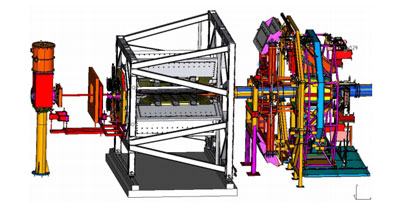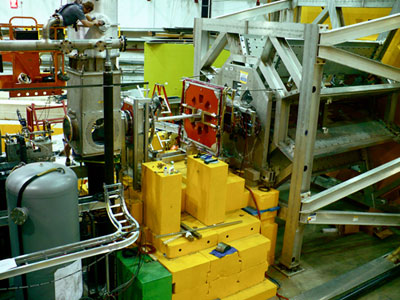The weak force is one of four fundamental forces, which include electromagnetism, gravity and the strong force.
The weak force acts on subatomic particles, such as the protons, neutrons and electrons that make up atoms. These particles carry a weak charge, a measure of the influence that the weak force can exert on them.
While the weak charge has not been measured precisely for the proton, its properties have been predicted by the Standard Model, the theory that describes protons, neutrons and other particles. By measuring the proton's weak charge in an experiment called Q-weak, scientists hope to gain insight into the Standard Model and perhaps lead to predictions of heavy particles, such as those that may be produced by the Large Hadron Collider at CERN in Europe.
"The weak charge for the proton is exquisitely, accurately predicted by the Standard Model. And so, what we are doing is taking a prediction that is very, very precise and testing it with a precise measurement," says Roger Carlini, a co-spokesperson for the Q-weak collaboration and a Hall C staff scientist.
In the experiment, a beam of electrons is directed into a container of liquid hydrogen. The electrons are polarized - mostly spinning in one direction, while the protons in the nuclei of the hydrogen atoms are unpolarized.
Some of the polarized electrons interact with the protons by striking glancing blows. These electrons are collected by a series of detectors that measure their direction and energy.

CAD layout of the Q-weak apparatus. The beam travels from left to right - through the red target and into the Q-weak detector system.
Broken Symmetry
To get a measurement of the weak force out of the behavior of these electrons, scientists are exploiting differences between two of the fundamental forces: the electromagnetic force and the weak force. When the electrons encounter the protons, they may interact through either of these forces.
One factor that affects this choice is the spin direction of the incoming electrons.
"We have the ability to rapidly change the polarization of the electrons, pointing in the direction of the beam and pointing opposite," Carlini says.
The experimenters flip the electrons' spin from one direction to the other a thousand times each second throughout the experiment, while recording how many interactions they get for each direction.
The electromagnetic force is unfazed by the electrons' spin direction. It treats electrons spinning one direction the same as those spinning opposite. The weak force, however, is picky. It preferentially reveals itself more often with electrons spinning in one direction versus the other.
While physicists will not be able to pick out which electrons they measure interacted with the protons via the electromagnetic force versus the weak force, they will be able to calculate the proton's weak charge by determining the difference in the number of electrons they measure for one spin direction versus the other.
"What we compute is what was different about that rate between the two. In other words, everything else cancels. And if there were no weak force, you'd get zero," explains Carlini. "What you actually get is something which is proportional to the weak charge of the proton. It's just a way of picking out the effective weak force."

The Q-weak apparatus during installation.
The Right Time for Weak
Carlini says this isn't the first measurement of the strength of the weak force. The European Organization for Nuclear Research, CERN, and Fermilab scientists, for instance, have made high-precision measurements of the weak force. However, those measurements were made of different particles (at higher energies).
"This measurement is building on thirty or forty years of developing experimental techniques. If it wasn't for all those other experiments, we couldn't do Q-weak, because we couldn't interpret it," Carlini says.
Some of those experimental techniques were developed at Jefferson Lab. For instance, the collaboration of scientists conducting the Hall A Proton Parity Experiment (HAPPEx, HAPPEx-II and HAPPEx-III) worked with CEBAF accelerator staff to fine-tune parameters of the accelerator's electron beam. The G-Zero experiment also made use of new techniques to separate the weak force from the electromagnetic. Lessons learned from these experiments and others were incorporated into the plans for the unique Q-weak measurement.
"It's a whole bunch of stuff that this place has that comes together that no one else in the world even comes close to at any time in the past or the present."
A Long Haul
From beginning to end, the Q-weak experiment will require more than a decade of effort. It was originally approved by Jefferson Lab in January of 2002, and the experimental run phase will wrap up in 2012.
The measurement was preceded by a nearly year-long installation period for the special equipment required to carry it out.
"It's a standalone experiment. We have our own detectors, our own magnet, a new beam line, a Compton polarimeter and a very high-power cryotarget," Carlini says.
Q-weak will run for approximately two years to get enough data to spot the effect of the weak force. Carlini and his colleagues are looking forward to settling into a routine.
"It's going to be a long haul: two years is a long time to run. And hopefully, we'll get into a quiet phase where we just take a lot of data and things don't change much."
Q-weak is the largest-installation experiment left on the books to run before the 12 GeV upgrade takes Jefferson Lab's CEBAF accelerator offline in 2012. It is also the last experiment scheduled to run in Hall C before the upgrade. Once the run is complete, scientists will begin the arduous process of interpreting the massive amounts of data they will have collected.
The Q-weak collaboration consists of more than 100 scientists and 50 institutions. It is funded by Jefferson Lab, the Department of Energy, the National Science Foundation and the Natural Sciences and Engineering Research Council of Canada.
Further Reading

